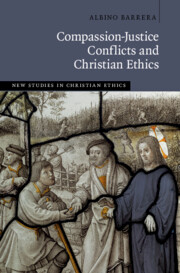Refine search
Actions for selected content:
50 results
Chapter 2 - Responsibilities and Obligations
- from Part I - Human Rights and State Responsibilities
-
- Book:
- The Politics of Human Rights
- Published online:
- 12 November 2025
- Print publication:
- 06 November 2025, pp 34-75
-
- Chapter
- Export citation
Chapter 18 - Financial services
-
- Book:
- Contemporary Australian Corporate Law
- Published online:
- 11 September 2025
- Print publication:
- 25 September 2025, pp 631-654
-
- Chapter
- Export citation
Editorial - Property Rights through Theory and Practice
-
- Journal:
- Asian Journal of Law and Society / Volume 12 / Issue 3 / September 2025
- Published online by Cambridge University Press:
- 11 August 2025, pp. 305-307
-
- Article
-
- You have access
- HTML
- Export citation
Ethical Foundations of Property: Socialising Property through Trusteeship
-
- Journal:
- Asian Journal of Law and Society / Volume 12 / Issue 3 / September 2025
- Published online by Cambridge University Press:
- 01 August 2025, pp. 394-414
-
- Article
- Export citation
4 - Co-ownership and Neighbour Relations
-
- Book:
- Property Law in China
- Published online:
- 09 July 2025
- Print publication:
- 24 July 2025, pp 98-125
-
- Chapter
- Export citation
6 - A Jurist in Search of Good Government
-
- Book:
- Neil MacCormick
- Published online:
- 22 May 2025
- Print publication:
- 12 June 2025, pp 242-300
-
- Chapter
- Export citation
Social Entrepreneurship and Obligations of Justice
-
- Journal:
- Social Philosophy and Policy / Volume 42 / Issue 1 / Summer 2025
- Published online by Cambridge University Press:
- 10 July 2025, pp. 82-101
- Print publication:
- Summer 2025
-
- Article
-
- You have access
- Open access
- HTML
- Export citation
Exploitation, Human Rights and Corporate Obligations
-
- Journal:
- Business and Human Rights Journal / Volume 9 / Issue 3 / October 2024
- Published online by Cambridge University Press:
- 06 January 2025, pp. 361-380
-
- Article
-
- You have access
- Open access
- HTML
- Export citation
11 - Commerce and Contracts
-
-
- Book:
- The Cambridge Comparative History of Ancient Law
- Published online:
- 09 May 2024
- Print publication:
- 30 May 2024, pp 565-597
-
- Chapter
- Export citation
Introduction
-
-
- Book:
- The Cambridge Handbook of Private Law and Artificial Intelligence
- Published online:
- 21 March 2024
- Print publication:
- 28 March 2024, pp 1-17
-
- Chapter
- Export citation
28 - Legal Personhood and AI
- from Part IV - Comparative Perspectives
-
-
- Book:
- The Cambridge Handbook of Private Law and Artificial Intelligence
- Published online:
- 21 March 2024
- Print publication:
- 28 March 2024, pp 618-635
-
- Chapter
- Export citation
CONSTITUTIONAL VALUES IN THE COMMON LAW OF OBLIGATIONS
-
- Journal:
- The Cambridge Law Journal / Volume 83 / Issue 1 / March 2024
- Published online by Cambridge University Press:
- 03 April 2024, pp. 132-157
- Print publication:
- March 2024
-
- Article
- Export citation
2 - The WTO Agreement as Community
-
- Book:
- A Communitarian Theory of WTO Law
- Published online:
- 14 December 2023
- Print publication:
- 21 December 2023, pp 55-107
-
- Chapter
- Export citation

Compassion-Justice Conflicts and Christian Ethics
-
- Published online:
- 19 October 2023
- Print publication:
- 02 November 2023
3 - Introduction to Swiss Contract Law
- from Part I - Introduction
-
- Book:
- Swiss Contract Law in International Commercial Arbitration
- Published online:
- 27 July 2023
- Print publication:
- 10 August 2023, pp 15-164
-
- Chapter
- Export citation
8 - How IOM Reshaped Its Obligations on Climate-Related Migration
- from Part II - IOM in Action
-
-
- Book:
- IOM Unbound?
- Published online:
- 15 June 2023
- Print publication:
- 29 June 2023, pp 213-234
-
- Chapter
-
- You have access
- Open access
- HTML
- Export citation
1 - Introduction
-
-
- Book:
- IOM Unbound?
- Published online:
- 15 June 2023
- Print publication:
- 29 June 2023, pp 1-42
-
- Chapter
-
- You have access
- Open access
- HTML
- Export citation
9 - The Workplace Reimagined, Part II
-
- Book:
- The Workplace Reimagined
- Published online:
- 11 May 2023
- Print publication:
- 25 May 2023, pp 144-176
-
- Chapter
- Export citation
2 - What Is Reciprocity?
-
- Book:
- Reciprocity in Public International Law
- Published online:
- 23 February 2023
- Print publication:
- 02 March 2023, pp 43-68
-
- Chapter
- Export citation
Conclusion
-
- Book:
- Reciprocity in Public International Law
- Published online:
- 23 February 2023
- Print publication:
- 02 March 2023, pp 259-263
-
- Chapter
- Export citation
